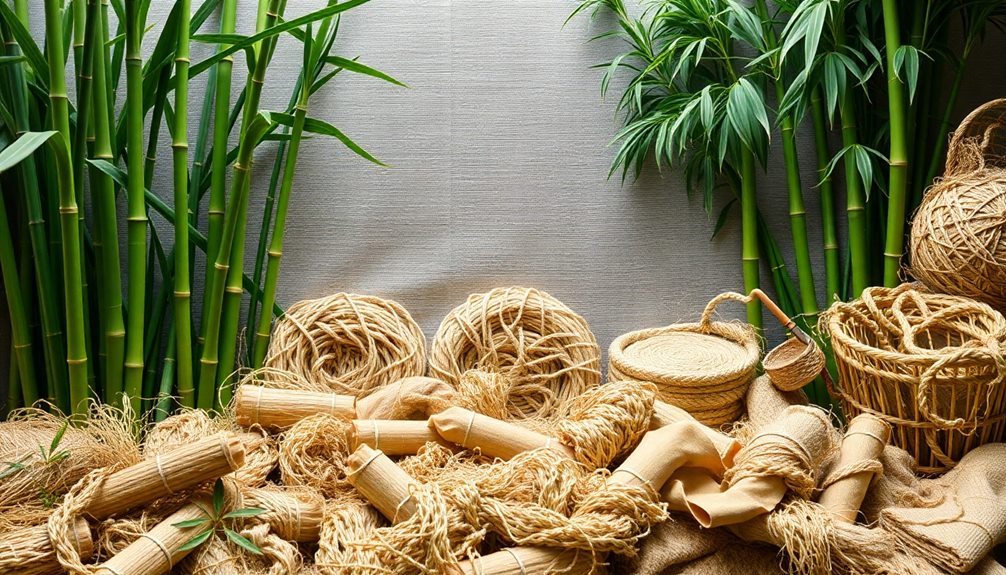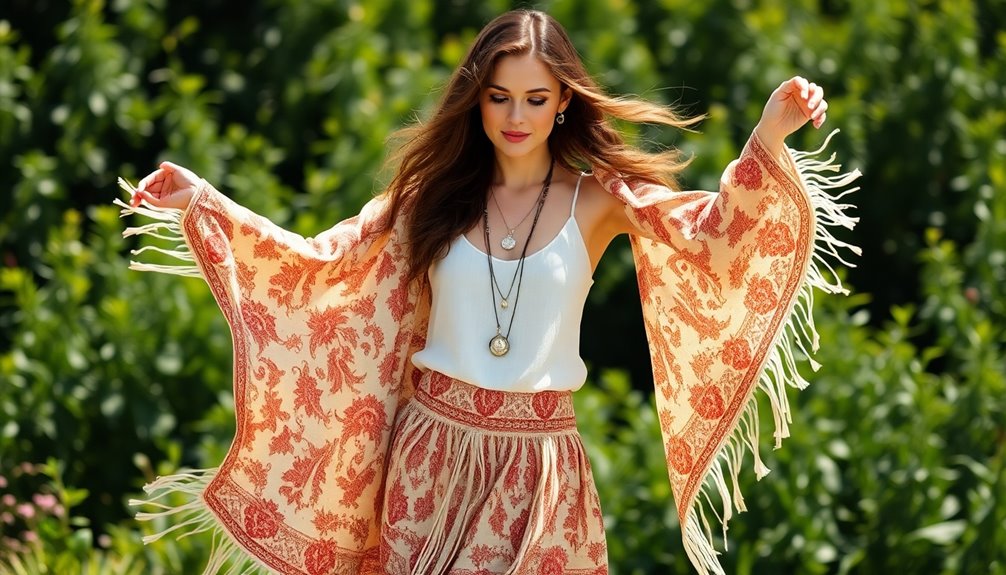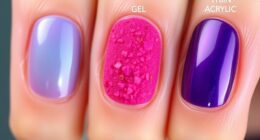Hemp and bamboo are at the forefront of sustainable textiles, offering you eco-friendly options that tackle the fashion industry's environmental issues. Hemp's durability and low water usage make it a strong choice, while bamboo's softness, moisture-wicking, and natural antibacterial properties enhance comfort. Both materials are biodegradable, promoting a circular economy. As consumer demand grows for sustainable products, brands are innovating with these fibers, but challenges in sourcing and processing remain. By exploring these trends further, you'll discover how hemp and bamboo are shaping the future of environmentally responsible fashion.
Key Takeaways
- Hemp and bamboo are emerging as sustainable alternatives to synthetic textiles due to their eco-friendly properties and minimal resource requirements.
- Hemp textiles are durable, biodegradable, and require less water and pesticides, making them an environmentally friendly choice.
- Bamboo fabrics exhibit natural antibacterial properties, moisture-wicking capabilities, and luxurious softness, enhancing comfort while promoting sustainability.
- Innovations in processing techniques are essential for scaling production and improving the supply chain for hemp and bamboo textiles.
- The shift towards these natural fibers supports local economies, encourages sustainable farming practices, and reduces reliance on synthetic materials.
Overview of Sustainable Textiles

Sustainable textiles are reshaping the fashion landscape by prioritizing eco-friendly materials and practices that notably reduce environmental impact. In recent years, the industry has begun to shift away from synthetic fibers, which made up 54% of total fiber production globally in 2022. This change is essential for minimizing textile waste, as less than 1% of discarded textiles are recycled into new clothing.
You'll find that natural fibers like bamboo and hemp are gaining popularity, especially in Southeast Asia. Local designers are embracing these materials, not only for their sustainability but also for the opportunity to create new agricultural revenue streams.
Compared to traditional crops like cotton, bamboo and hemp require considerably less water and pesticides, making them more environmentally friendly choices.
Moreover, innovative materials, including biodegradable fabrics and concepts of circular fashion, are pushing the industry toward a more sustainable future. By choosing sustainable textiles, you're contributing to a movement that aims to drastically reduce the fashion industry's ecological footprint.
Embracing these changes now can lead to a cleaner, greener planet for future generations.
Benefits of Hemp Textiles

Hemp textiles offer a range of benefits that make them a standout choice in the movement towards eco-friendly fashion. One important advantage is their natural resistance to mold and UV rays, which makes hemp fabrics ideal for various climates and applications where durability is essential. This durability translates into a longer lifespan for products, reducing the need for frequent replacements and enhancing sustainability.
Additionally, incorporating sustainable materials like hemp can boost the overall nutrient density of products, similar to how chia seeds enhance nutrition in vegan diets.
Moreover, hemp is a breathable material, ensuring comfort whether you're wearing it casually or during active pursuits. Compared to cotton, hemp requires considerably less water and pesticides for cultivation, making it an eco-friendlier option in textile production. This reduction in resource use directly contributes to a smaller environmental footprint.
Moreover, hemp's status as a biodegradable material means it decomposes naturally at the end of its life cycle, promoting a circular economy in fashion. By choosing hemp textiles, you're not just opting for high-quality fabrics; you're actively participating in a sustainable movement that values both environmental health and product longevity.
Embracing hemp is a step towards a more responsible and eco-conscious wardrobe.
Advantages of Bamboo Fabrics

When you choose bamboo fabrics, you're opting for a material that's naturally antibacterial, which helps keep odors at bay.
Its breathability and moisture-wicking abilities guarantee you stay dry and comfortable, no matter the climate.
Additionally, selecting products that are sustainably sourced, like bamboo, can contribute to safety regulations that favor eco-friendly practices.
Plus, the eco-friendly production process means you're supporting sustainable practices while enjoying luxurious comfort.
Natural Antibacterial Properties
Discovering the natural antibacterial properties of bamboo fabrics reveals numerous advantages that make them a standout choice for hygiene-focused applications. Bamboo contains a bio-agent called "bamboo kun," which effectively inhibits the growth of bacteria and fungi. Laboratory tests show that bamboo textiles can reduce bacterial growth by up to 99.8% within 24 hours. This remarkable capability guarantees that you have cleaner and fresher products in your daily life.
Additionally, the use of natural materials, like bamboo, is aligned with the principles of a raw food diet focusing on unprocessed, health-promoting options, highlighting a growing trend towards sustainability.
The antibacterial properties of bamboo fabrics not only help maintain hygiene but also make them suitable for sensitive skin. Their soft texture and breathable nature minimize the risk of irritation or allergic reactions, making it a preferred option for many.
Plus, bamboo's moisture-wicking capabilities keep the fabric dry, further discouraging microbial growth.
As a biodegradable material, bamboo fabric stands out in the domain of natural fabrics. Its ability to decompose without releasing harmful substances into the environment enhances its sustainability appeal.
Breathable and Moisture-Wicking
Bamboo fabrics offer exceptional breathability and moisture-wicking properties that make them ideal for active lifestyles. When you choose bamboo textiles, you'll enjoy comfort and performance, especially during workouts or warm weather.
Here's what makes bamboo stand out:
- Naturally Moisture-Wicking: Bamboo absorbs and evaporates sweat efficiently, keeping you dry and comfortable.
- Luxurious Softness: The texture of bamboo rivals silk, providing a soft feel against your skin.
- Highly Breathable: Bamboo promotes airflow, reducing the chances of overheating during physical activities.
- Antibacterial Benefits: Its natural antibacterial properties minimize odor retention, keeping your clothes fresher for longer.
- Sustainable Choice: As a fast-growing plant, bamboo can be harvested sustainably, aligning with eco-friendly practices.
With these advantages, bamboo fabrics not only elevate your wardrobe but also support your active lifestyle.
Whether you're hitting the gym or enjoying a day outdoors, you'll appreciate the breathable and moisture-wicking qualities of bamboo textiles.
Choosing sustainable textiles like bamboo means you're not just looking good; you're also making a positive impact on the environment.
Eco-Friendly Production Process
The eco-friendly production process of bamboo fabrics stands out for its minimal environmental impact. By utilizing a low-impact method that requires little chemical treatment, you're making a conscientious decision for the planet.
Bamboo, a highly renewable resource, grows incredibly fast—up to 91 cm (35 inches) in just 24 hours. This rapid growth means less agricultural land is needed, preserving valuable natural resources.
When you choose bamboo fabrics, you're opting for a sustainable choice that generates less waste compared to conventional cotton. The entire bamboo plant can be effectively used in the production process, ensuring that nothing goes to waste.
Plus, bamboo requires considerably less water—about one-third of what cotton needs—further solidifying its status as an eco-friendly option.
Adding to these benefits, bamboo textiles boast natural antibacterial properties, which minimize the need for chemical finishes. This not only enhances the eco-friendly production profile but also contributes to healthier clothing options.
Innovations in Textile Production
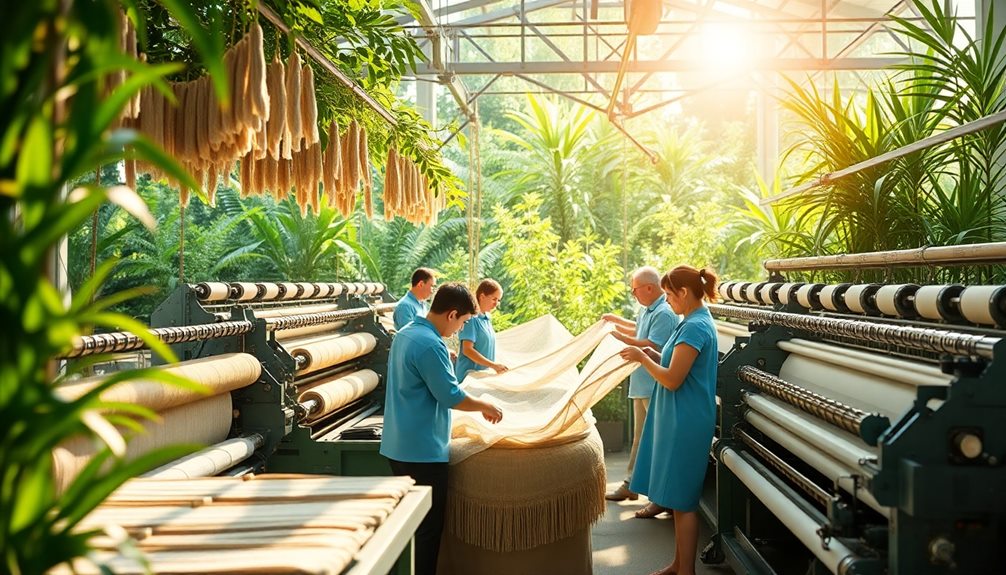
In recent years, innovations in textile production have transformed the industry, making sustainable materials like bamboo and hemp more accessible and appealing.
These advancements not only enhance the eco-friendliness of fabrics but also meet the growing consumer demand for high-quality, durable textiles.
Here are some key innovations shaping the future of textile production:
- Sustainable Cultivation: Bamboo and hemp require minimal water and pesticides, reducing the environmental impact.
- Enhanced Processing Techniques: Innovations in processing bamboo and hemp fibers are essential for scaling up production and improving supply chains.
- Antimicrobial Treatments: Integrating new technologies helps develop fabrics that resist bacteria, enhancing their functionality and longevity.
- Design Flexibility: Designers in Thailand are shifting from silk to bamboo, appreciating its softness and breathability.
- Durability of Hemp: Hemp fabrics are naturally resistant to mold and UV rays, making them a long-lasting choice.
With these textile innovations, you can feel good about choosing sustainable materials like bamboo and hemp, knowing they contribute to a greener future while meeting the demands for quality and performance.
Challenges in Sustainable Sourcing
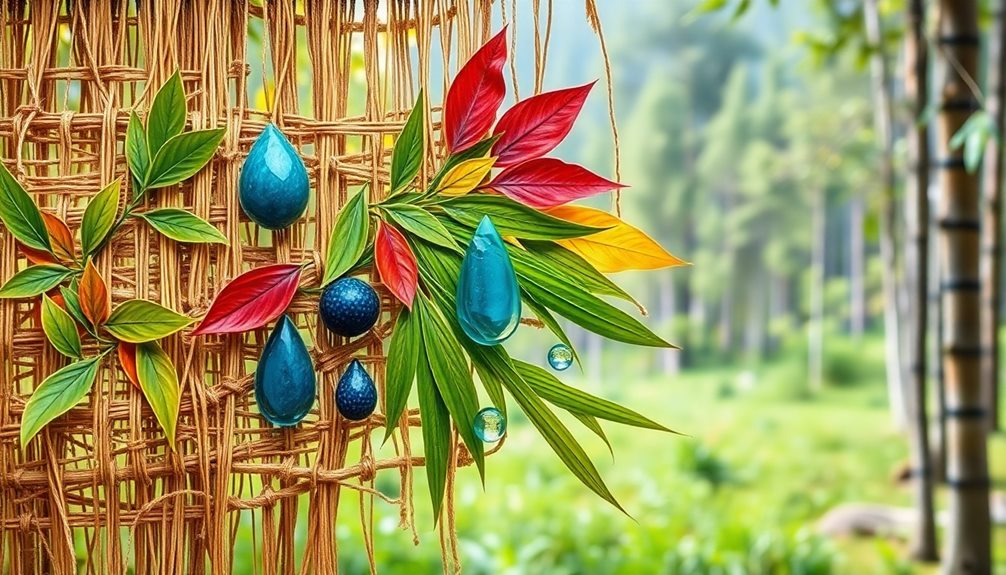
When you think about sustainable sourcing, you'll quickly realize that scaling up production of materials like bamboo and hemp is no easy feat.
Established cultivation practices and processing techniques are still catching up, which can limit the availability and quality of these fibers.
Plus, with a majority of raw materials in fashion still coming from synthetic sources, making that shift to natural fibers presents its own set of challenges.
Production Scaling Difficulties
Scaling up sustainable textile production, particularly with materials like bamboo and hemp, presents a set of formidable challenges.
You'll encounter several production scaling difficulties that can hinder progress in the fashion industry.
- Cultivation Techniques: Improved farming methods for bamboo and hemp are still under development, impacting yield and quality.
- Supply Chains: Current supply chains for these sustainable textiles aren't fully established, risking bottlenecks in sourcing.
- Investment Needs: Shifting to bamboo and hemp requires significant investment in refining processing techniques, which can be resource-intensive.
- Training Requirements: Southeast Asia's existing textile infrastructure needs adaptation and training for farmers and manufacturers to embrace sustainable practices.
- Agricultural Strain: Increased demand for bamboo and hemp can overwhelm local agricultural systems, threatening sustainability and supply quality.
These challenges need addressing to create a robust market for sustainable textiles.
Processing Technique Limitations
Addressing the challenges of production scaling naturally leads to the limitations of processing techniques for sustainable textiles like bamboo and hemp. These fibers require advanced processing techniques that are still evolving, impacting the overall quality and efficiency of sustainable textile production.
As you explore bamboo and hemp, you'll notice that the current supply chains are developing but face significant hurdles in cultivation and consistent sourcing of raw materials.
Scaling up production isn't just about quantity; it's about refining how these fibers are processed. Many local producers struggle with access to the necessary equipment and knowledge, which can stifle growth in the sustainable textile market.
Without improved processing techniques, the unique properties of bamboo and hemp may not be fully utilized, limiting their potential.
The shift to sustainable textiles hinges on overcoming these processing limitations. By investing in better technology and education, you can help reveal the environmental benefits and market potential of bamboo and hemp.
As you navigate the world of sustainable textiles, keep these challenges in mind, as they’re essential to the industry’s future growth and success. Additionally, the availability of sustainable fabric options may be limited, making it difficult for businesses to source and use these materials in their products. This can lead to higher production costs and may affect the pricing of sustainable textiles in the market. Companies will need to find ways to innovate and adapt to these challenges, whether it’s through the development of new sustainable materials or finding more sustainable ways to produce and distribute existing options. Overall, addressing these challenges will be crucial in ensuring the long-term viability of sustainable textiles in the fashion industry.
Economic Impact on Local Communities
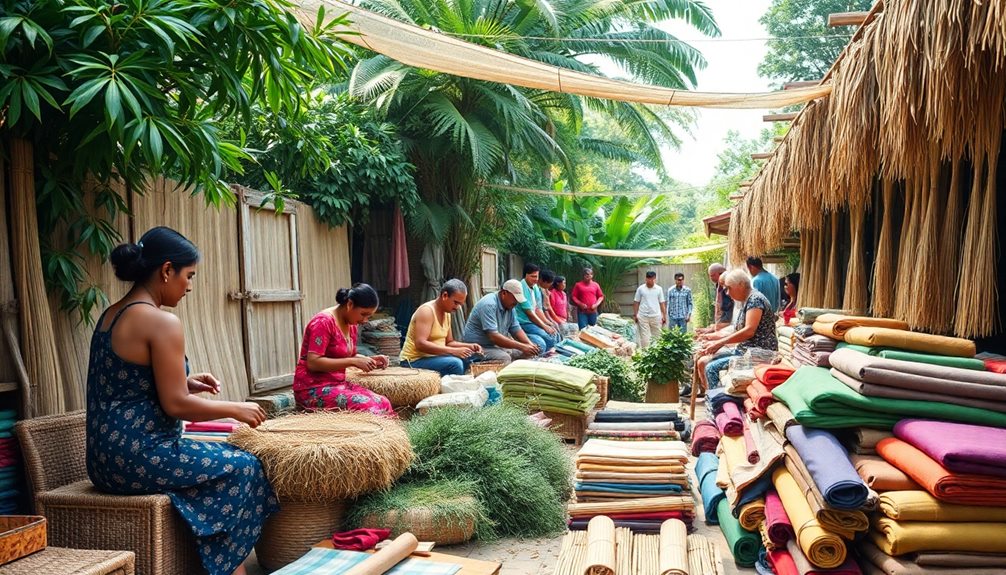
Sustainable textiles are reshaping the economic landscape of local communities, particularly in Southeast Asia. By embracing hemp and bamboo, you're witnessing a surge in agricultural revenue that bolsters local economies. The demand for these eco-friendly materials isn't just improving farmers' financial stability; it's also creating jobs across various sectors.
- Increased job opportunities in cultivation and processing
- Local designers promoting regional craftsmanship
- Greater investment in sustainable agricultural practices
- Boosted creativity and innovation in fashion
- Improved economic resilience for rural communities
This shift towards sustainable textiles is more than just a trend; it's a lifeline for many. As local farmers pivot away from traditional crops, they're not only preserving the environment but also enhancing their livelihoods.
The focus on eco-friendly materials helps protect the natural resources that you and your community rely on. As local artisans and manufacturers innovate with these materials, they're fostering a vibrant market that uplifts everyone involved.
In embracing sustainable textiles, you're not just contributing to fashion; you're becoming part of a larger movement that revitalizes local economies and empowers communities.
Future Trends in Fashion Industry

As we move further into the 21st century, the fashion industry is rapidly evolving to meet the demands of conscious consumers.
You're likely to see a significant shift towards sustainable materials like bamboo and hemp, which are becoming popular alternatives to traditional textiles. Southeast Asia is leading this charge, with local designers embracing these next-gen materials to reduce their environmental impact.
Expect to witness a rise in biodegradable and recycled fibers within the global textile market as brands focus on circular fashion practices.
Companies like Adidas and Stella McCartney are already utilizing innovative plant-based leathers and biobased synthetic fibers, demonstrating that sustainability doesn't have to sacrifice style.
With the anticipated regulatory landscape, such as the EU Strategy for Sustainable and Circular Textiles, brands will increasingly adopt recycled and sustainable materials to meet new environmental standards.
This shift isn't just a trend; it's a necessary evolution for the industry.
As a conscious consumer, you'll find more options that align with your values, paving the way for a more sustainable future in fashion.
Embrace these changes, and enjoy the stylish, eco-friendly choices that lie ahead.
Consumer Demand for Eco-Friendly Materials

Growing awareness around environmental issues has sparked a significant shift in consumer demand for eco-friendly materials in the fashion industry.
Today, you're part of a movement where 66% of global consumers are willing to pay more for sustainable brands. This change is fueled by the harmful effects of fast fashion, with 73% of you adjusting your buying habits to reduce your carbon footprint.
The sustainable fashion market was valued at approximately $6.5 billion in 2022 and is poised for substantial growth, driven by your desire for transparency and sustainability. A striking 81% of millennials expect brands to be upfront about their sourcing practices, leading many to adopt eco-friendly textiles like hemp and bamboo.
Here are a few factors shaping this demand:
- Increased awareness of textile waste
- Preference for natural fibers over synthetic options
- Growing interest in biodegradable materials
- Desire for transparency in sourcing
- Support for sustainable brands
As you prioritize eco-friendly materials in your clothing choices, the industry responds with innovative solutions that cater to your values, ensuring a more sustainable future for fashion.
Case Studies of Successful Brands

In the domain of eco-friendly fashion, several brands are making significant strides by integrating innovative materials into their collections. Thakorn Somwat, a Thai designer, is at the forefront with his bamboo textile products, highlighting the softness and breathability of this sustainable material while promoting eco-conscious fashion in Thailand.
Pinatex, crafted from agricultural pineapple waste, has gained traction since 2016, being adopted by over 500 brands, and proving that sustainable materials can thrive in mainstream fashion.
Lululemon also joins the movement, incorporating Tencel—a branded lyocell known for its high absorption and eco-friendly production—into their activewear, emphasizing the importance of natural fibers.
Adidas showcases its commitment to sustainability by using Mylo, a mycelium leather alternative, across various products.
In the luxury sector, Stella McCartney has pioneered the use of plant-based leather alternatives like Mirum, demonstrating that natural materials can redefine high-end fashion.
These case studies illustrate how brands are successfully maneuvering the shift towards sustainable textiles, making a significant impact on the industry and encouraging consumers to embrace eco-friendly choices.
Frequently Asked Questions
Is Bamboo More Sustainable Than Hemp?
You'll find bamboo generally more sustainable than hemp due to its rapid growth, minimal water needs, and energy-efficient processing. Its natural antibacterial properties and biodegradability further enhance its appeal for eco-conscious consumers like you.
Is Hemp a Sustainable Textile?
Yes, hemp's incredibly sustainable; it uses 50% less water than cotton. Its durability means products last longer, and it's biodegradable, reducing waste. By choosing hemp, you're supporting eco-friendly practices and sustainable agriculture.
What Is the Most Sustainable Bamboo Fabric?
The most sustainable bamboo fabric's made from mechanically processed bamboo. You'll appreciate its biodegradability and natural antibacterial properties, plus it supports local economies while minimizing environmental impact without harmful chemicals or intensive energy use.
What Are Next Generation Materials in Fashion?
Next-generation materials in fashion include sustainable options like recycled textiles, biobased synthetics, and innovative alternatives. You'll find options like AirCarbon and Mylo that reduce environmental impact while enhancing performance, meeting your eco-friendly needs.
Conclusion
As you wander through a lush forest of sustainable textiles, you'll find hemp's sturdy roots anchoring the ground while bamboo towers gracefully above, swaying in the breeze. Each thread tells a story of innovation and resilience, weaving together communities and the environment. Just as nature thrives on diversity, the future of fashion flourishes with eco-friendly materials. Embrace this journey, and let your choices reflect a world where style and sustainability dance hand in hand.
